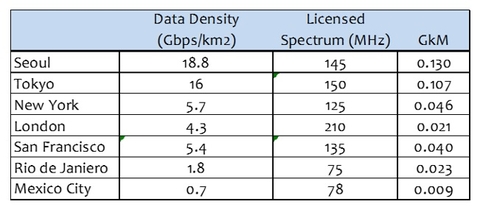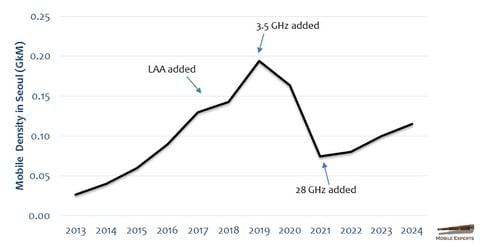Over the past eight years, Mobile Experts has published some highly accurate forecasts for small cell deployment. The number of small cells shipped in 2016 was within 4% of our forecasted number. How did we do it? We tracked the mobile traffic levels in more than 20 LTE networks worldwide, and we predicted the use of small cells based on the density of the mobile traffic levels.
We calculate the density based on Gbps of traffic per square kilometer, for a dense urban hotspot during the “busy hour” of the day. For each network that we track, we select the busiest sector that we can find, and calculate Gbps per square kilometer. Then we divide by the amount of mobile spectrum used to compare density per MHz. The resulting metric, Gbps/km2/MHz, is a conversation-stopper, so we call it GkM instead.

We’ve noticed over the years that when mobile operators reach a level of 0.02 GkM, the economics of small cells become more attractive than macro sites for added capacity. This has been extremely accurate as a way to predict the timing and use of small cells.

Looking to the future, we expect some changes in traffic density that will influence the decisions of the operators. Consumer trends are driving more mobile video traffic, so the level of traffic keeps increasing quickly. However, CBRS and LAA spectrum will be utilized, adding more LTE bandwidth and reducing traffic density per MHz. The net impact is that the increase of traffic density will slow down.
Based on the success of excellent networks in Japan and Korea, we believe that LTE-Advanced networks can be extended to a level somewhere between 0.15 and 0.2 GkM before the LTE network reaches its limits. At some point, small cells and macro base stations reach a practical limit, where interference will prevent further increases in traffic and additional small cells become expensive to deploy.
Without massive MIMO, somewhere above 0.15 GkM the mobile network would begin to saturate. However, we believe that massive MIMO will provide more room for growth. As m-MIMO is deployed in both LTE and 5G systems, the density of the network should be able to continue growing beyond 0.2 GkM.
In real-world networks, there’s plenty of room for growth. Most major networks are anticipating about 50-100 MHz of new spectrum at 3.5 to 4.5 GHz, and many countries have plans for wider blocks above 20 GHz.

Seoul is a good example. In Korea, some of the most dense networks in the world will be pushing the envelope of saturation in the 2019 timeframe, but the addition of 3.5 GHz and 28 GHz spectrum will dramatically reduce density of traffic, improving network quality. In addition, the use of massive MIMO will push the saturation point higher, so that when Korean networks reach density levels of 0.2 GkM again in the 2028 timeframe, higher spatial and spectral efficiency will allow for high network quality at that level.
Overall, this model has become an indispensable tool in predicting the behavior of the mobile operators. Stay tuned: We will be watching Asian networks to better understand what happens to networks as they “saturate,” and how the mm-wave spectrum can be used to offload networks at high density.
Joe Madden is Principal Analyst at Mobile Experts LLC, a network of market and technology experts that analyze wireless markets. The team provides detailed research on Small Cell, Base Station, Carrier Wi-Fi, and IoT markets. Mr. Madden currently focuses on trends in 5G, IoT, and Enterprise markets for wireless infrastructure. Over 26 years in mobile communications, he accurately predicted the rise of Digital Predistortion, Remote Radio Heads, Small Cells, and the rise of a Mobile IT market. He validates his ideas with mobile and cable operators, as well as semiconductor suppliers, to find the match between business models and technology. Mr. Madden holds a physics degree from UCLA. Despite learning about economics at Stanford, he still obeys the laws of physics.
